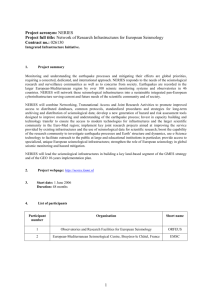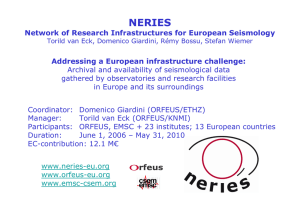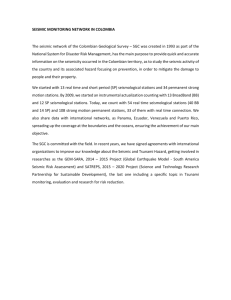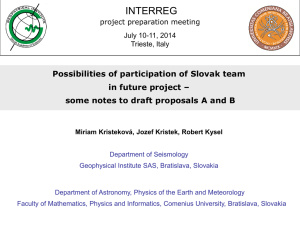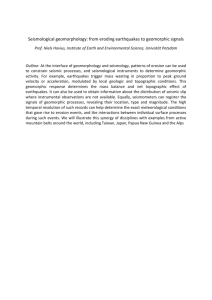Network of Excellence of Research and Infrastructures for
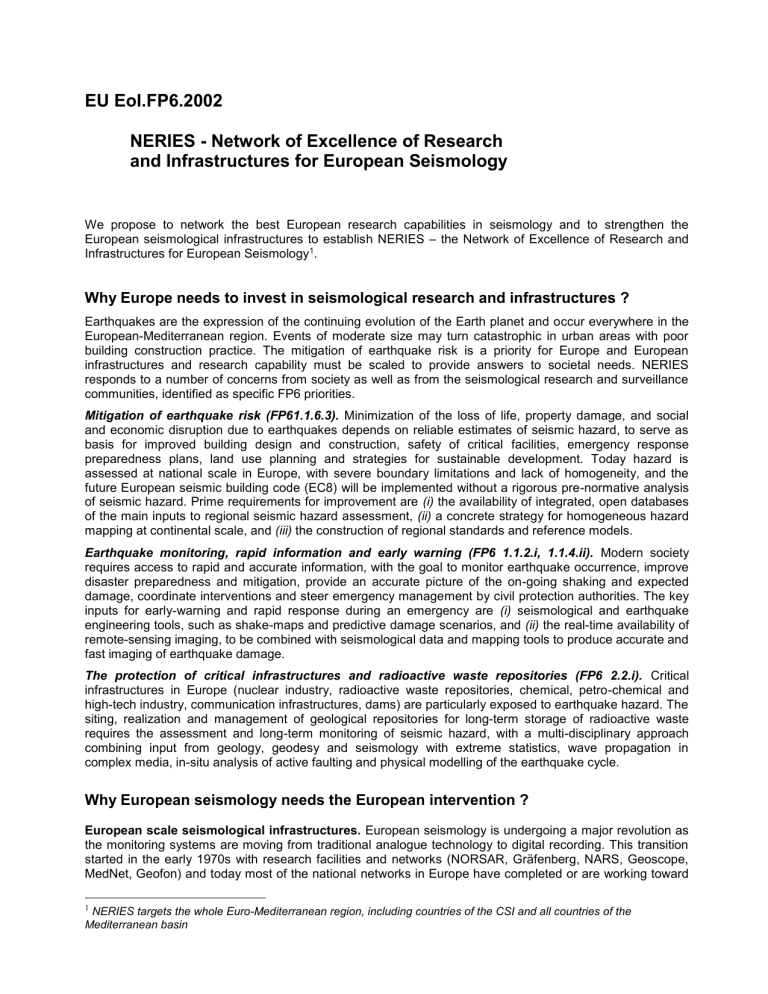
EU EoI.FP6.2002
NERIES - Network of Excellence of Research and Infrastructures for European Seismology
We propose to network the best European research capabilities in seismology and to strengthen the
European seismological infrastructures to establish NERIES – the Network of Excellence of Research and
Infrastructures for European Seismology 1 .
Why Europe needs to invest in seismological research and infrastructures ?
Earthquakes are the expression of the continuing evolution of the Earth planet and occur everywhere in the
European-Mediterranean region. Events of moderate size may turn catastrophic in urban areas with poor building construction practice. The mitigation of earthquake risk is a priority for Europe and European infrastructures and research capability must be scaled to provide answers to societal needs. NERIES responds to a number of concerns from society as well as from the seismological research and surveillance communities, identified as specific FP6 priorities.
Mitigation of earthquake risk (FP61.1.6.3). Minimization of the loss of life, property damage, and social and economic disruption due to earthquakes depends on reliable estimates of seismic hazard, to serve as basis for improved building design and construction, safety of critical facilities, emergency response preparedness plans, land use planning and strategies for sustainable development. Today hazard is assessed at national scale in Europe, with severe boundary limitations and lack of homogeneity, and the future European seismic building code (EC8) will be implemented without a rigorous pre-normative analysis of seismic hazard. Prime requirements for improvement are (i) the availability of integrated, open databases of the main inputs to regional seismic hazard assessment, (ii) a concrete strategy for homogeneous hazard mapping at continental scale, and (iii) the construction of regional standards and reference models.
Earthquake monitoring, rapid information and early warning (FP6 1.1.2.i, 1.1.4.ii). Modern society requires access to rapid and accurate information, with the goal to monitor earthquake occurrence, improve disaster preparedness and mitigation, provide an accurate picture of the on-going shaking and expected damage, coordinate interventions and steer emergency management by civil protection authorities. The key inputs for early-warning and rapid response during an emergency are (i) seismological and earthquake engineering tools, such as shake-maps and predictive damage scenarios, and (ii) the real-time availability of remote-sensing imaging, to be combined with seismological data and mapping tools to produce accurate and fast imaging of earthquake damage.
The protection of critical infrastructures and radioactive waste repositories (FP6 2.2.i).
Critical infrastructures in Europe (nuclear industry, radioactive waste repositories, chemical, petro-chemical and high-tech industry, communication infrastructures, dams) are particularly exposed to earthquake hazard. The siting, realization and management of geological repositories for long-term storage of radioactive waste requires the assessment and long-term monitoring of seismic hazard, with a multi-disciplinary approach combining input from geology, geodesy and seismology with extreme statistics, wave propagation in complex media, in-situ analysis of active faulting and physical modelling of the earthquake cycle.
Why European seismology needs the European intervention ?
European scale seismological infrastructures. European seismology is undergoing a major revolution as the monitoring systems are moving from traditional analogue technology to digital recording. This transition started in the early 1970s with research facilities and networks (NORSAR, Gräfenberg, NARS, Geoscope,
MedNet, Geofon) and today most of the national networks in Europe have completed or are working toward
1 NERIES targets the whole Euro-Mediterranean region, including countries of the CSI and all countries of the
Mediterranean basin
EU EoI.FP6.2002 NERIES 2 fully digital systems. Within 5 years, hundreds of permanent broadband seismic observatories will be deployed in Europe, operated by almost 40 different networks. The availability of this expanded recording capacity provides new challenges and new opportunities. Presently, the European infrastructures for seismology are ORFEUS (Observatories and Research Facilities for European Seismology; serving since
1987 as European centre for the research community) and the EMSC (European-Mediterranean
Seismological Centre; founded in 1976 to collect earthquake parameters and to provide rapid warning, it is based on key nodal members). ORFEUS and EMSC are supported through national and institutional quotas.
The European intervention is required to:
- build a lasting large-scale seismological infrastructure in Europe, capable to accommodate the rapid shifts in technology and political conditions and to guarantee the continued commitment needed for the long-term observation of the Earth;
evolve from the present mosaic of national and regional networks toward an effective European Virtual
Seismic Network (EVSN), providing instant access to hundreds of stations;
guarantee the storage and retrieval of seismic data for decades and centuries in the future;
build a centralized data archive to complement national databases in storing and distributing all
European data for permanent stations and temporary experiments (e.g., Europrobe, EGT);
offer a safe back-up storage, distribution facilities and quality control for national data-centres;
provide national agencies with real-time access to waveforms collected outside their territory .
European instrument pools. National networks and regional programs build the bulk of the European instrumental coverage, with investments in instrumentation and surveillance activities valued at few hundreds million Euro over a 10 yr period. However, the European intervention is needed in two domains:
even with the completion of instrumental projects already under way, the coverage of European land will remain highly inhomogeneous in the mid-term future; a European pool of instruments is required to build a semi-permanent network to cover areas devoid of adequate instrumental monitoring, serving both surveillance needs and research priorities;
two thirds of the Euro-Mediterranean region sit under water, and the most damaging earthquakes in
European history (Siracusa, 1693; Lisbon 1755; Messina 1908) also happened in sea areas. We need a concrete plan for long-term seismological monitoring and research investigations of the European seas.
The need to boost analysis capability (FP6 1.1.4.ii). The availability of hundreds of broad-band seismic stations and satellite imagery on-line will allow to tackle the investigation of the Earth structure and of the earthquake process in unprecedented detail. Europe will be at the forefront of monitoring capability, together with some areas in the western US and Asia (Japan, Taiwan). No European centre can handle this data availability alone. The European seismological community needs to: join its forces on key scientific questions, boost its capacity of data-processing and waveform modelling, develop new theoretical and numerical tools, harness its computational capacity in a distributed European architecture and construct models of the Earth structure and of the earthquake cycle which build themselves by harvesting the required data from the on-line EVSN stations.
Europe versus the US. Seismological infrastructures in the US and Europe are organized differently, with national agencies playing a very strong role in Europe in network operations and data distribution. Although individual national investments in monitoring programs throughout Europe are on par with the US, European infrastructures are an order of magnitude and more smaller than similar existing centres in the US. With comparable area, seismic hazard and risk exposure, the US is setting up a backbone of centralized federal facilities and national-scale projects to supplement the regional and local networks. In Europe, boundaries and different national priorities limited so far the establishment of an efficient regional co-operation; the larger amount of data remains scattered over tens of observatories and data-centres and is practically inaccessible for large-scale scientific investigations and surveillance; while several successful projects have been supported by the EU FP5 and ESF, our seismological community remains fragmented and because of this it often lacks the critical mass to work effectively on large-scale issues and to cooperate and compete evenly with US and Japanese counterparts. Today, European seismology is loosing ground and needs to regain a leading edge in research and surveillance. We need to build upon the experience and results of past projects to achieve the critical mass and the level of excellence required by modern seismological investigations, and to focus our research priorities on key goals of relevance for science as well as for our society.
EU EoI.FP6.2002 NERIES 3
NERIES key actions
To respond to the concerns and needs expressed above, we propose to establish NERIES – the Network of
Excellence of Research and Infrastructures for European Seismology. NERIES will work along three lines:
I. build up the Europe-wide infrastructure capacity as an integral complement to national centres
II. network the efforts of the prime European research facilities on three strategic research areas of societal relevance and build an integrated European Research Area in Seismology
III. establish a training and mobility program for efficient build-up of research excellence and widespread transfer of technology and research excellence
I. Building the European seismological infrastructure and service of the future
ORFEUS and EMSC will be up-scaled to build the backbone of the future European infrastructure. The following actions are designed as integrating activities , to foster new cooperative research and surveillance at continental scale: The proposed actions will be carried out by nodal members and leading technical laboratories associated to ORFEUS and the EMSC:
The central ORFEUS Data Centre will be expanded into a European-scale infrastructure to store events and continuous waveform data from all European stations and networks, to increase the permeability of
European data exchange by coordinating the access to national network centres, to provide real-time access to all waveforms, to build a safe duplicate archive for national data-centres, to build and maintain a European-wide Virtual Seismic Network, to implement an integrated Data Management
Centre (DMC) with the US counterpart IRIS-DMC, to boost the role of European networks in the global earthquake surveillance coordinated under the Federation of Digital Seismic Networks.
ORFEUS and EMSC will develop an integrated earthquake early-warning system for the Euro-
Mediterranean region, combining real-time processing of earthquake parameters, continuous modelling of the seismic wavefield, on-line shake-maps, remote-sensing imaging and damage scenarios. A public information system for on-line mapping of shake-maps and scenarios will be implemented, to serve as basis for civil protection alert and public information.
ORFEUS will acquire a European instrumental pool for semi-permanent deployments in areas with sparse station coverage; ORFEUS-DMC will build the infrastructure to assist in temporary seismic deployments and archive waveform data from mobile and semi-permanent experiments at European scale; the EMSC will archive the derived parametric data.
ORFEUS will acquire and coordinate with leading marine geophysics labs the installation of a first
European Ocean Bottom Seismographic Network, deployed along the European continental margins and in the Mediterranean to complement the land-based networks, enlarging the participation to OBS science to smaller research institutes and countries (this is intended as first phase, and could be expanded or merged in a larger integrated project focusing on ocean bottom science).
The EMSC will develop and maintain regional integrated databases for seismic hazard assessment (i.e. macro- and paleo-seismic, parametric, active faults, strong-ground motion records and attenuations, soil classifications, vulnerability classes and inventories, hazard models, case studies of critical earthquakes) to serve as a basis for earthquake engineering applications and pre-normative EC8 research at the European scale.
II. European Research Area in Seismology
NERIES will target three areas of seismological research where significant advancements are expected by a concerted effort over the next 5-10 year timescale. These research areas complement the infrastructural build-up described above. When completed, they will set the basis for future surveillance and research activities at Euro-Mediterranean scale.
II.1 Developing a European reference model . We will combine travel-time and surface wave tomographic modelling and the results from past active-passive seismic experiments to produce the first combined reference model for the Euro-Mediterranean region. The model will be provided with tools for 3D earthquake location and waveform propagation, to serve as a basis for national earthquake surveillance applications as
EU EoI.FP6.2002 NERIES 4 well as further research advancements. Theoretical and methodological developments are expected in the field of high-frequency wave propagation in complex media. The European standard model will be constructed to build itself continuously by harvesting the required data from the on-line waveforms. We will harness our computational capability in a distributed European architecture for massive wavefield modelling.
II.2 Assessment of seismic hazard . We will develop methodologies and means for the future generation of seismic hazard assessment, also for very low annual occurrence frequencies and for areas of slow deformation. To this end we will combine crustal strain-rates from seismic and geodetic data (GPS, SAR), earthquake statistics tools, physical models of earthquake generation, constraints from long-term behaviour of active faults and paleo-seismological investigations, knowledge of local site effects and modelling of spectral ground shaking. This cross-disciplinary work will establish the methodology and the collaborative basis for a pan-European seismic hazard zonation map for EC8 in its current format and also anticipating future developments related to performance-based design objectives. We will include expertise in earthquake engineering and insurance to identify current and future seismological needs of earthquakeresistant design and loss modeling. This collaboration between Earth scientists and engineers will serve to build up hazard estimates in a variety of formats, including scenario events and the definition of acceleration time-histories to represent the expected motions. This will include guidelines for the selection and scaling of real records and guidelines on suitable input parameters for the generation of synthetic motions. For safetycritical facilities, particular attention will be given to hazard estimates for very long return periods, with emphasis on the nature of scatter in strong-motion estimates, the characteristics of near-fault motions and their upper bounds.
II.3 Early-warning tools . We will combine real-time results from seismological centres, on-line data from
European stations, advanced waveform modelling, geological constraints and engineering calibrations to develop accurate shake mapping and damage scenarios. The availability of waveforms from the ORFEUS
European Virtual Seismic Network will allow to map in real-time on-going shaking; we will combine regional attenuation models of spectral strong ground motion with regional geological mapping and soil classifications to account for site effects; where available, microzoning schemes will be included; damage scenarios will be derived from shake-maps by convolution with vulnerability functions calibrated for the European building stock. We will develop the basis for the future detailed modelling of individual critical areas for European seismic safety.
III. Fostering and transferring excellence
NERIES will network the participating centres in targeted research teams; support the exchange of researchers and of PhD students; coordinate the scientific exchanges and the transfer of technology among the network of excellence and the partners of the ORFEUS/EMSC consortium; maintain an enhanced outreach programme, including a program for seismological instrumentation in European schools and public forums on seismic safety and risk mitigation; organize courses and workshops to advance the knowledge on using broad-band instrumentation and waveform modelling; promote the learning of seismology in European
Master and Graduate Schools; promote joint research projects and excellence in seismological practice in countries bordering the European Union (Eastern Europe, Middle East, North Africa) and assist these countries to establish and operate digital seismic networks.
How NERIES fits in the EU FP6
NERIES fulfils the main criteria and priorities set in the EU FP6:
It focuses on key scientific goals of relevance for our society: the mechanisms and mitigation of natural disasters and natural hazard monitoring (FP6 1.1.6.3), the bases for sustainable development (FP6
1.1.6.3), the tools for an efficient information society (FP6 1.1.2.i), the safety of critical infrastructures and of geological repositories of radioactive waste (FP6 2.2.i), the development of technologies for harnessing distributed computing and storage resources for complex problem solving (FP6 1.1.2.i), the build-up of satellite-based information systems in environmental monitoring (FP6 1.1.4.ii), the combination of spatial and terrestrial data in an integrated operational information system (FP6 1.1.4.ii).
It complements the national investments in instrumentation and surveillance with required European integrating measures; it fights the fragmentation of the seismological community to build the critical
EU EoI.FP6.2002 NERIES 5 mass to work effectively on large-scale problems; it brings together the geological, seismic hazard, engineering seismology, waveform modelling and network communities on a common agenda.
It builds upon the experience and results of past projects in FP5 and ESF in hazard research (RHISE,
SESAME, SAFE, RELIEF, CORSEIS, PRESAP, GSHAP, IGCP-SESAME), infrastructure (SINIS,
GEOSTAR, ORION, MOMAR), data exchange (MEREDIAN), unified European databases (EPSI,
BEECD, ISESD), exploration (EuroProbe, EGT) and rapid warning systems (RWS).
It targets a set of lasting improvements, which will not create dependence, but structure the new standards for future research and surveillance in the Euro-Mediterranean region.
It complements other EoIs focussing on information systems for natural hazards and civil protection
(NATRISK), integrated ocean-bottom science (GLOMARC, ESONET), earthquake mechanics and forecasting (INLAB, RIBENSEIS), space technologies (STREAM_EVOH), earthquake engineering.
The NERIES Network of Excellence
Fifteen universities and research centres build the backbone of NERIES, each centre bringing a unique combination of expertise and excellence to the network. In addition, the consortia ORFEUS and EMSC participate as partners, combining the required infrastructures and enlarging NERIES to encompass most of the European research centres in seismology in a wider framework, including also institutes in countries in the CSI and in the Eastern and Southern Mediterranean which actively cooperate in research and/or surveillance. The precise NERIES composition will be defined based on the call for proposals, and more partners will be added to the core group listed here.
ETH Zurich, Switzerland
GFZ, Potsdam, Germany
Utrecht University, the Netherlands
INGV, Roma, Italy
IPG Paris, France
Karlsruhe University, Germany
Grenoble University, France
Imperial College, London, UK
Oxford University, UK
KOERI, Uni.Bogazici, Istanbul, Turkey
University of Thessalonicki, Greece Istituto Geografico Nacional, Madrid, Spain
NORSAR, Norway
LDG/CEA, Bruyères-le-Chatel, France
European-Mediterranean Seismological Centre
IPGS-EOST, Strasbourg, France
ORFEUS, at KNMI, de Bilt, the Netherlands
The ORFEUS and EMSC membership listed by country (the centres listed above are omitted):
Armenia : NSSP. Austria : ZAMG. Belgium : Observatoire Royal de Belgique. Bulgaria: GI BAS.
Cyprus :
Geological Survey Department. Czech Republic : Inst. Geophysics ASCR-GI Prague, Charles University
Praha, Institute of Physics of the Earth Brno. Denmark : Nat. Survey and Cadastre. Egypt : NRIAG. Finland :
Inst. Seismology. Estonia: Geol. Survey.
France : Uni.Nice, Uni.Nantes, Uni.Paris6, Uni.Montpellier,
Uni.Brest, Bureau Central de Sismologie Français, BRGM, LCPC. Germany : Gräfenberg Obs., Uni.
Frankfurt, Schiltach Obs., Uni.Stuttgart, Uni.München, Uni.Hamburg, Uni.Bochum, Uni.Jena, Uni.Leipzig,
Uni.Potsdam, BGR. Greece : UniAthens, NOAIG Athens, ITSAK. Hungaria: GGRI HAS.
Iceland : Icelandic
Meteorological Office. Ireland : Inst. Adv. Studies Dublin. Israel : Geophys. Inst. Israel Lov, Nuclear Res. Inst.
Javna. Italy : Uni.Trieste, Uni.Napoli, Uni.Genova, Uni.Bologna, Servizio Sismico Nazionale, OGS Trieste,
Politecnico Milano, Storia Geofisica Ambiante. Lebanon : Geophysics Centre at Bhannes. Malta : UniMalta.
Morocco : CNR. Norway : Uni. Bergen, Uni.Oslo. Poland : IG-PAS. Portugal : Uni.Lisbon, Inst. Superior
Tecnico, Inst. de Meteorologia. Rumania : Nat. Inst. Earth Phys. Bucarest, Russia : Uni.St.Petersburg, CGDS,
IGE-RAS. Saudi Arabia : King Abdulaziz City for Sciences & Tech. Slovak Republic : Slovac AS. Slovenia :
EARS Ljublijana, Geophysical Survey. Spain : Inst. d'Est. Catalan Barcelona, Univ. Complutense Madrid,
Univ. Polit. Madrid, Ebro Obs, Uni.Granada, Inst. Cartografico Cataluna, Uni.Barcelona, CSIC Barcelona.
Sweden : Geoscience Inst. Uppsala. Turkey : Earthquake Res. Dept. UK : BGS, Bullard Lab. Uni. Cambridge,
Blacknest, Uni. Leicester, Uni. Edinburg, Uni. Leeds, Uni. East Anglia, Uni. Bristol.
The realization of the European Ocean Seismographic Network will rely on the expertise in research centres
(GEOMAR Kiel, IPG Paris, INGV Roma, Southampton Oceanographic Centre, Uni.Hamburg) as well as in specialized industry.
Network Coordinator: Prof. D. Giardini, ETH Zurich, Chair of ORFEUS Board of Directors
Managing Consortium : ORFEUS - Organizations and Research Facilities for EUropean Seismology
